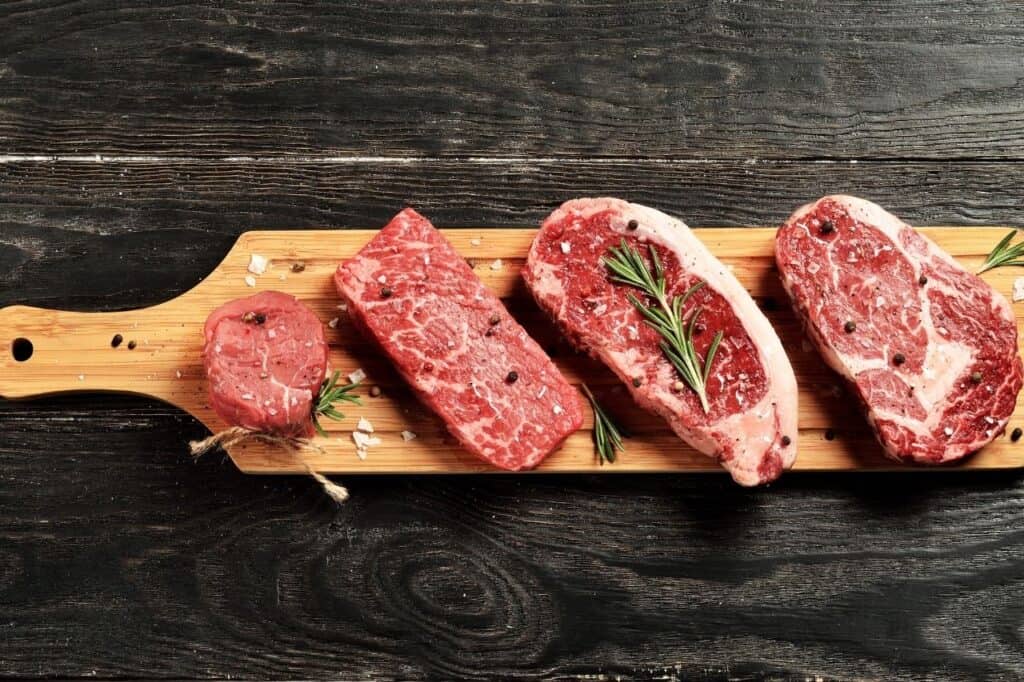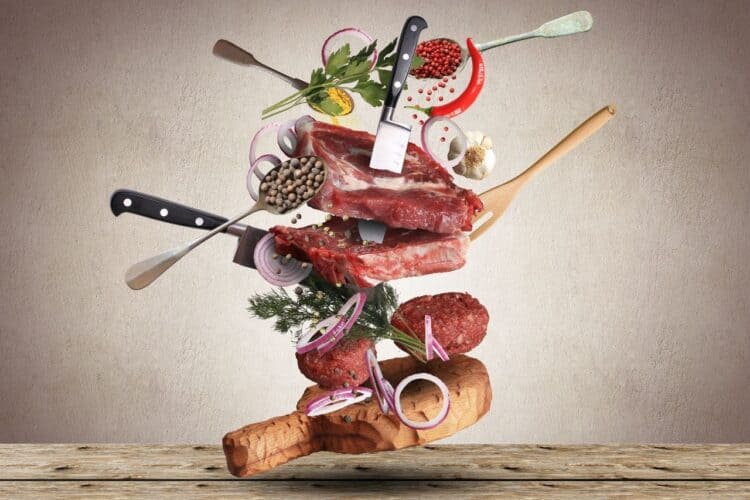Whenever I invite guests to our home, one of my struggles is preparing the right amount of food for them. It’s either I prepare too much or sometimes not enough to feed everyone, which is kinda embarrassing. After hosting several BBQ parties at home, I was able to learn how to calculate just the right amount of food for everyone.
As a general guideline, prepare at least 1/3lb (150g) of cooked meat for every person. However, depending on your guests’ appetite, this can be increased to 1/2lb (227g) if they are big eaters. The amount of meat to serve can still vary if there’s a side dish or not.
While 1/3 lb (150g) is the recommended amount per serving, it will still depend on whether your guests are adults, kids, or teenagers.
How Much Meat To Buy

When buying meat, it is important to consider that raw meat will shrink once it has been cooked. The recommended serving stated above is for cooked meat, so you need to increase the weight when buying raw meat. Aside from the weight, you also need to decide whether the meat will be served with other dishes or not.
It may seem hard to decide how much you need to buy. But when planning a barbecue party, it will be easier if you look at it as a whole. For instance, if you have three additional side dishes to serve, it would be safe to serve each guest at least 1/3 lb (150g) of meat as your main dish. If your guests have children, you also need to count them but with smaller servings, about half of what adults can eat.
The type of side dishes you will serve can also be a factor. For example, if you are serving veggies such as grilled vegetables or salad, they may not be as filling compared to potato or pasta dishes. Creamy and high-carb dishes are more filling.
Adding a variety of meats such as brisket and chicken can also make a difference in how much main dish you need to prepare. I prefer serving my guests with different kinds of meat like chicken wings and pulled pork.
When in doubt, you can always use the palm-size rule to visualize how much meat you need. Take a look at your hand, and the size per person would be your palm size. This is what caterers usually use when calculating the amount of food per person.
What Is Yield?
As discussed earlier, the weight of raw meat changes when it’s cooked. The yield is the amount of meat left to serve after the trimmings, bones, and when the meat has shrunk after cooking. Most of the time, you don’t get the whole serving of those quarter-pounder burgers that you order in fast food.
The weight mentioned is typically raw, and once it’s cooked, burgers typically shrink by 31%. This is because moisture and fat are lost during cooking.
It is important to know how much moisture and fat is lost after cooking so you can buy the right amount of raw product. To give you an idea, if you are planning to serve burgers, ground beef usually loses about 30% of fat when cooked. This should give you an idea of how much raw meat you need.
To save you the trouble of calculating the yield number, here’s a guide on the yields of some of the most common meats after cooking.
| Meat | Yield |
|---|---|
| NY Strip Steak | 84% |
| Pork Shoulder | 62% |
| Brisket | 50% |
| Whole Turkey | 50% |
| Baby Back Ribs | 50% |
Understanding the yield can give you an idea of how much raw meat you need to buy and how much weight will be left after cooking and all the trimmings. This will help ensure that you serve enough food for everyone, and they leave with a happy tummy.
Serving Size Per Person Depending On Type Of Meat
Beef Brisket
Beef brisket contains a lot of fat inside and outside, so expect to lose at least 50% of it after cooking. If you purchase 12 pounds (5443 grams), you’ll only get around 6 pounds (2722 grams). Depending on how big your guest’s appetite is, you can serve at least 4 ounces (113 grams) for sandwiches. If you are feeding big eaters or athletes, increase it to at least 1 pound (453 grams) each.
Pulled Pork
Pork shoulder or Boston butt is what you will typically use for pulled pork. It can be bone-in or out. A big percentage is lost for pulled pork since most of its fat melts during cooking or is trimmed away, plus don’t forget the bones.
From bones alone, you lose 35-50%. For 8lbs (3629g) of pork shoulder, your yield is around 4.5 lbs (1814g). This can feed at least 10-15 adults depending on your side dishes and their appetite. For plates, you can serve each person around 1/3 lb (453g), and for sandwiches around 1/4lb (113g).
Steak
For steaks, it can be a bit more complicated as you need to know the type of steak you will serve. You’ll likely get less if you use porterhouse or T-bones, which means you need to serve more head. For NY Strip steak, expect a yield of 89% and for porterhouse and T-bones, around 77%.
The sample yields are for trimmed and pre-cut steaks. Prepare at least 17oz (482g) per person for bone-in steak and for boneless steak around 13oz (369g).
Ribs
When it comes to ribs, instead of weight, a lot of people count the number of ribs. A typical 1/2 rack of baby back ribs has 6-7 ribs. If you have several sides to go with your baby backs, you can allot at least 3 ribs per head. Of course, size varies whether you are serving baby back ribs or spare ribs.
Spare ribs have bigger bones and have more fat. 2 1/2lbs (1133g) of spare ribs can feed at least 3 or 4 persons. Baby back ribs are smaller and shorter, so 2 1/2lbs (1133g) can only feed 2 persons.
Chicken
It’s the same with chicken, better to count parts and pieces rather than weight. For boneless chicken, plan on serving at least 1.5 pieces per head. For bone-in chicken, 2 pieces per person should be enough. Again, consider serving other sides and meats for this serving portion. When it comes to chicken parts, match wings with breasts or thighs and drumsticks.
Fish
For fish like salmon and bass, you can lose around 30% after cooking. Typically, 8oz (226g) of fish is served per person.
Tips For Planning A Perfect Barbecue Party

After hosting numerous barbecue parties for my family and friends, I have gained enough knowledge on how much food to serve, which sides to prepare, etc. So, here are a few tips to make your next barbecue event a success.
- Decide the side dishes you want to serve and whether they are light or heavy. This will give you an idea of how much meat you need to buy.
- If you are doing a lunch BBQ party, consider how long the lunch would be. In the case of having a long lunch, expect guests to graze. And If it takes place during dinner, expect visitors to eat more.
- You also need to consider the people who are coming. Ask if they will be bringing kids. Will there be more men than women? Knowing this information can help you decide what type of food to serve and how much. Men tend to eat more than women in general. If there are kids, make sure to prepare kid-friendly foods as well.
- You also need to decide whether it’s an informal or formal gathering.
- If you are planning a buffet, serve the secondary meats and sides first before your main dish. This will let your guests fill their plates before they reach the main meat.
- When serving other meats like sausages, cut them into smaller pieces. This will allow them to try a bit of all your sides.
- If you are serving alcohol, keep in mind that people tend to eat more with alcohol, so be prepared.
- Serve desserts; this will encourage your guests to leave some room for sweets and avoid overindulging.
- Take time to know your guests. Find out if they have food allergies or if some are vegetarians.
- Lastly, prepare ahead of time. Make sure you have all the ingredients you need a day before.
Related Questions
You actually do not need to eat meat every day because you can find the required nutrients you get from eating meat from other food sources. But if you are a meat lover, the daily recommended serving for a 2,000 calorie diet according to USDA is 5 1/2 (155g) ounces of lean pork, poultry, or beef to get all the dietary benefits of meat.
The standard serving of boneless meat per person is ½ lb (226g) per adult and ¼ lb (113g) per child. For meat with bones, the rule of thumb is 1lb (453g) per adult and ½ lb (226g) per child.
- Does Using Pellet Smokers Dry Out Meat? – Myth or Fact - January 4, 2022
- 12 Best Meats To Cook On A Pellet Smoker - December 30, 2021
- Dry Brining: What, How, Why & More - December 28, 2021


